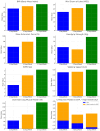Stay Active, Stay Healthy: A Cross-Sectional View of the Impact of Physical Activity Levels on Health Parameters of Older Adults Institutionalized in Nursing Homes of Barcelona
- PMID: 40141756
- PMCID: PMC11943667
- DOI: 10.3390/life15030412
Stay Active, Stay Healthy: A Cross-Sectional View of the Impact of Physical Activity Levels on Health Parameters of Older Adults Institutionalized in Nursing Homes of Barcelona
Abstract
(1) Background: Institutionalized older adults represent a vulnerable population. It is important to understand that higher levels of physical activity in older adults are associated with less risk of cardiovascular diseases, better cognition, and lower inflammaging and sarcopenia levels. The main objective was to evaluate the differences in health parameters in institutionalized older adults who perform different levels of weekly physical activity. The secondary objective was to analyze if weekly physical activity levels are a predictor of health parameters. (2) Methods: A cross-sectional observational study was conducted in nursing homes with adults over 75 years of age. A total of 76 participants was divided into three groups based on their weekly physical exercise frequency (1 day/week, 2 days/week, and 3 days/week). We measured demographic and anthropometric variables, along with cognitive level through the Mini Exam of Lobo. Handgrip strength, leg muscle strength, and power were also evaluated, and C-reactive protein levels were assessed through blood tests. Physical performance was measured using the Short Physical Performance Battery and walking speed. (3) Results: Significant differences were found in body mass index (p < 0.01; ES = 0.96), muscular strength (p < 0.01; ES = 0.70), and power (p < 0.01; ES = 1.09), Short Physical Performance Battery (p < 0.01; ES = 1.46) and walking speed (p < 0.01; ES = 0.87), cognitive function (p < 0.01; ES = 1.21), and C-reactive protein levels (p < 0.01; ES = 1.73), favoring the group who performed 3 days/week of physical activity. (4) Conclusions: Institutionalized older adults with three days per week of physical activity have greater physical and muscle function and less cognitive decline. Three days of weekly physical activity is associated with systemic inflammation and better cognitive status in institutionalized older adults.
Keywords: aging; institutionalization; older adults; physical activity; sarcopenia; sedentarism.
Conflict of interest statement
The authors declare no conflicts of interest.
Figures
References
-
- Tøien T., Nielsen J.L., Berg O.K., Brobakken M.F., Nyberg S.K., Espedal L., Malmo T., Frandsen U., Aagaard P., Wang E. The impact of life-long strength versus endurance training on muscle fiber morphology and phenotype composition in older men. J. Appl. Physiol. 2023;135:1360–1371. doi: 10.1152/japplphysiol.00208.2023. - DOI - PMC - PubMed
-
- Beswick A.D., Rees K., Dieppe P., Ayis S., Gooberman-Hill R., Horwood J., Ebrahim S. Complex interventions to improve physical function and maintain independent living in elderly people: A systematic review and meta-analysis. Lancet. 2008;371:725–735. doi: 10.1016/S0140-6736(08)60342-6. - DOI - PMC - PubMed
Grants and funding
LinkOut - more resources
Full Text Sources
Research Materials




